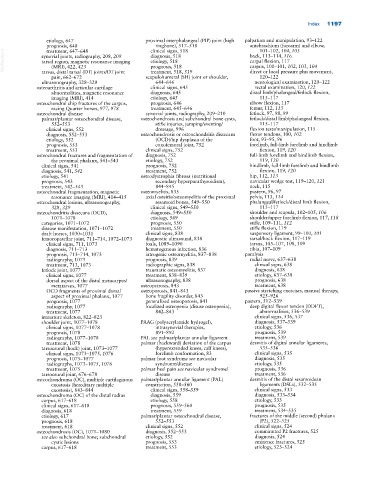Page 1231 - Adams and Stashak's Lameness in Horses, 7th Edition
P. 1231
Index 1197
etiology, 647 proximal interphalangeal (PIP) joint (high palpation and manipulation, 93–122
prognosis, 648 clinical signs, 518 antebrachium (forearm) and elbow,
ringbone), 517–518
101–102, 104, 105
treatment, 647–648
VetBooks.ir synovial joints, radiography, 208, 209 diagnosis, 518 back, 113–114, 116
tarsal region, magnetic resonance imaging
etiology, 518
carpal flexion, 117
carpus, 100–101, 102, 103, 104
prognosis, 518
(MRI), 422, 423
tarsus, distal tarsal (DT) joints/DT joint
treatment, 518, 519
120–122
pain, 662–672 scapulohumeral (SH) joint or shoulder, direct or local pressure plus movement,
ultrasonography, 328–329 644–646 neurological examination, 120–122
osteoarthritis and articular cartilage clinical signs, 645 rectal examination, 120, 122
abnormalities, magnetic resonance diagnosis, 645 distal limb/phalangeal/fetlock flexion,
imaging (MRI), 414 etiology, 645 115–117
osteochondral chip fractures of the carpus, prognosis, 646 elbow flexion, 117
racing Quarter horses, 977, 978 treatment, 645–646 femur, 112, 113
osteochondral disease synovial joints, radiography, 209–210 fetlock, 97, 98, 99
palmar/plantar osteochondral disease, osteochondrosis and subchondral bone cysts, fetlock/distal limb/phalangeal flexion,
552–553 stifle injuries, jumping/eventing/ 115–117
clinical signs, 552 dressage, 996 flexion tests/manipulation, 115
diagnosis, 552–553 osteochondrosis or osteochondritis dissecans flexor tendons, 100, 102
etiology, 552 (OCD)/hip dysplasia of the foot, 93–95, 96
prognosis, 553 coxofemoral joint, 752 forelimb, full‐limb forelimb and hindlimb
treatment, 553 clinical signs, 752 flexion, 119, 120
osteochondral fractures and fragmentation of diagnosis, 752 full‐limb forelimb and hindlimb flexion,
the proximal phalanx, 541–543 etiology, 752 119, 120
clinical signs, 541 prognosis, 752 hindlimb, full‐limb forelimb and hindlimb
diagnosis, 541, 542 treatment, 752 flexion, 119, 120
etiology, 541 osteodystrophia fibrosa (nutritional hip, 112, 113
prognosis, 543 secondary hyperparathyroidism), navicular wedge test, 119–120, 121
treatment, 542–543 844–845 neck, 115
osteochondral fragmentation, magnetic osteomyelitis, 835 pastern, 96, 97
resonance imaging (MRI), 414–415 axial osteitis/osteomyelitis of the proximal pelvis, 113, 114
osteochondral lesions, ultrasonography, sesamoid bones, 549–550 phalangeal/fetlock/distal limb flexion,
328, 329 clinical signs, 549–550 115–117
osteochondritis dissecans (OCD), diagnosis, 549–550 shoulder and scapula, 102–105, 106
1071–1078 etiology, 549 shoulder/upper forelimb flexion, 117, 118
categories, 1071–1072 prognosis, 550 stifle, 109–111, 112
disease manifestation, 1071–1072 treatment, 550 stifle flexion, 119
draft horses, 1030–1031 clinical signs, 838 suspensory ligament, 99–100, 101
femoropatellar joint, 711–714, 1072–1073 diagnostic ultrasound, 838 tarsal/hock flexion, 117–119
clinical signs, 711, 1073 foals, 1089–1090 tarsus, 105–107, 108, 109
diagnosis, 711–713 hematogenous infection, 836 tibia, 107–109
prognosis, 713–714, 1073 iatrogenic osteomyelitis, 837–838 paralysis
radiography, 1073 prognosis, 839 radial nerve, 637–638
treatment, 713, 1073 radiographic signs, 838 clinical signs, 638
fetlock joint, 1077 traumatic osteomyelitis, 837 diagnosis, 638
clinical signs, 1077 treatment, 838–839 etiology, 637–638
dorsal aspect of the distal metacarpus/ ultrasonography, 838 prognosis, 638
metatarsus, 1077 osteopetrosis, 843 treatment, 638
OCD fragments of proximal dorsal osteoporosis, 841–843 passive stretching exercises, manual therapy,
aspect of proximal phalanx, 1077 bone fragility disorder, 843 925–926
prognosis, 1077 generalized osteoporosis, 841 pastern, 512–539
radiography, 1077 localized osteopenia (disuse osteopenia), deep digital flexor tendon (DDFT),
treatment, 1077 842–843 abnormalities, 536–539
immature skeleton, 822–823 clinical signs, 536, 537
shoulder joint, 1077–1078 PAAG (polyacrylamide hydrogel), diagnosis, 537–539
clinical signs, 1077–1078 intrasynovial therapies, etiology, 536
prognosis, 1078 891–892 prognosis, 539
radiography, 1077–1078 PAL see palmar/plantar annular ligament treatment, 539
treatment, 1078 palmar (backward) deviation of the carpus desmitis of digital annular ligaments,
tarsocrural (hock) joint, 1073–1077 (hyperextended knees, calf knees), 535–536
clinical signs, 1073–1075, 1076 forelimb conformation, 83 clinical signs, 535
prognosis, 1075–1077 palmar foot syndrome see navicular diagnosis, 535
radiography, 1073–1075, 1076 syndrome/disease etiology, 535
treatment, 1075 palmar heel pain see navicular syndrome/ prognosis, 536
tarsocrural joint, 676–678 disease treatment, 536
osteochondroma (OC), multiple cartilaginous palmar/plantar annular ligament (PAL) desmitis of the distal sesamoidean
exostosis (hereditary multiple constriction, 558–560 ligaments (DSLs), 532–535
exostosis), 843–844 clinical signs, 558–559 clinical signs, 533
osteochondroma (OC) of the distal radius diagnosis, 559 diagnosis, 533–534
carpus, 617–618 etiology, 558 etiology, 533
clinical signs, 617–618 prognosis, 559–560 prognosis, 535
diagnosis, 618 treatment, 559 treatment, 534–535
etiology, 617 palmar/plantar osteochondral disease, fractures of the middle (second) phalanx
prognosis, 618 552–553 (P2), 522–525
treatment, 618 clinical signs, 552 clinical signs, 524
osteochondrosis (OC), 1071–1080 diagnosis, 552–553 comminuted P2 fractures, 525
see also subchondral bone; subchondral etiology, 552 diagnosis, 524
cystic lesions prognosis, 553 eminence fractures, 525
carpus, 617–618 treatment, 553 etiology, 523–524

